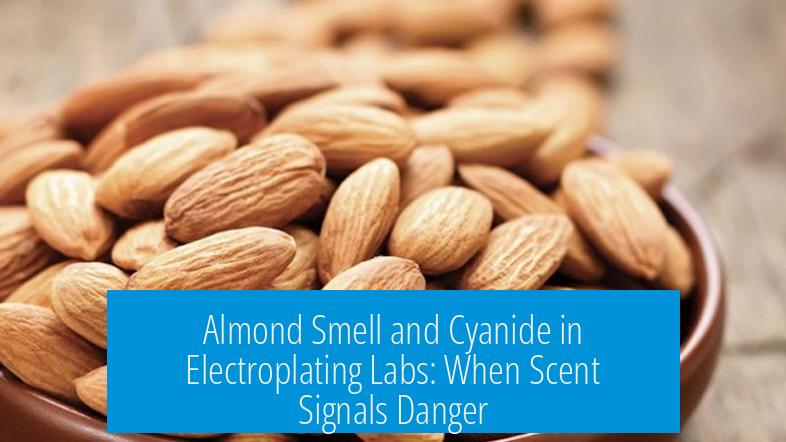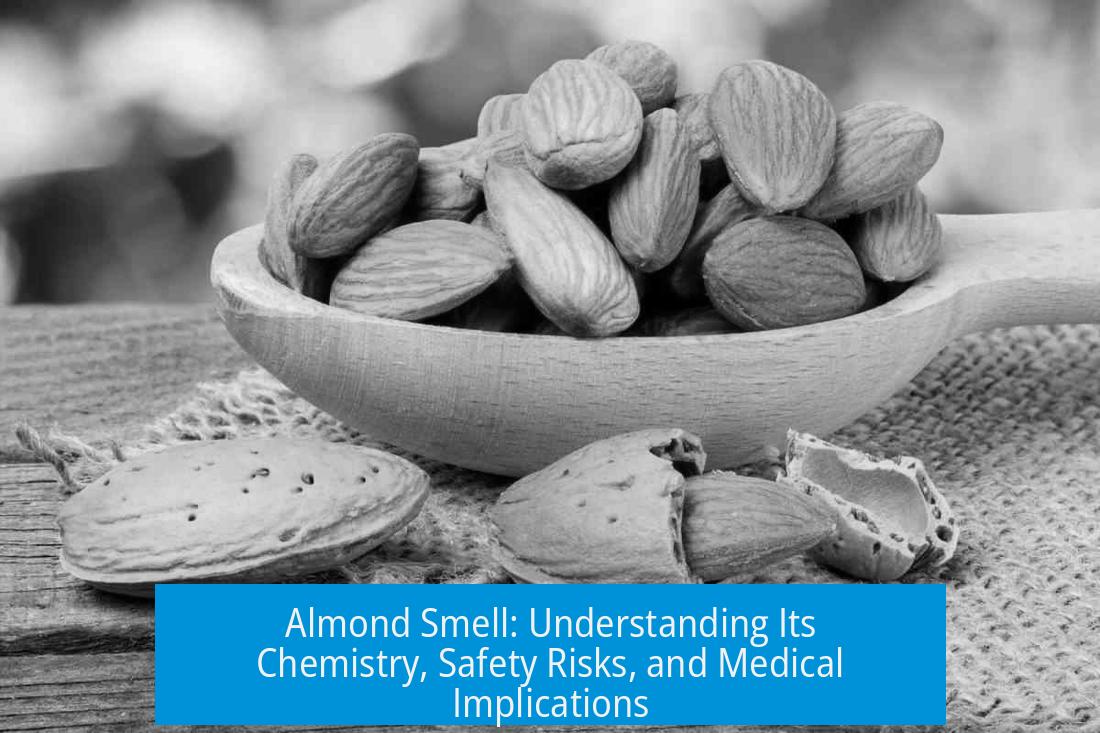Understanding the Almond Smell: Chemistry and Safety Implications

The almond smell often associated with certain chemical environments, especially those involving cyanide compounds, can signal potential hazards. In electroplating labs, detecting this scent requires immediate precaution due to the risk of hydrogen cyanide gas exposure.
Almond Smell and Cyanide in Electroplating Labs
Cyanide salts play a significant role in electroplating as additives. Usually, these cyanides bind tightly to metal ions within plating baths, preventing their evaporation into the air. The salts themselves lack a distinct odor since they are not volatile under normal conditions.
However, if the cyanide concentration becomes excessive or if the bath’s pH drops below a controlled high level, hydrogen cyanide (HCN) gas may form and escape. This gas is volatile and responsible for the characteristic “almond” smell many associate with cyanide.
In an electroplating environment, this scent should never be ignored. It signals the potential presence of HCN, a deadly gas. A safe response upon detecting this smell is immediate evacuation of personnel along with ventilation of the area if feasible.
- Safety Protocols: Ventilate the area promptly or evacuate.
- Monitoring: Watch for symptoms like severe fatigue and weakness.
- Emergency Response: Use oxygen where available and administer antidotes such as amyl nitrite if cyanide exposure is suspected.
HCN Characteristics and Risks
Hydrogen cyanide carries a bitter, acrid odor, sometimes described as burnt almonds or faintly pyridine-like. However, perceptions vary, and some experts involved in large-scale HCN production report never detecting an almond smell. This discrepancy highlights the subjective nature of olfactory detection.
Even low concentrations—around 5 parts per million (ppm)—can irritate the sinuses and mouth. Higher exposure risks dizziness, unconsciousness, and death. HCN’s high flammability adds to the danger, emphasizing the need for protective equipment, including self-contained breathing apparatus (SCBA) and level A chemical suits.
The Prank Incident: Misuse of Almond Smell
There are documented cases of almond scent being used maliciously to simulate HCN leaks. For example, a prank involved placing almond extract on steam lines near plating tanks, producing an artificial aroma meant to alarm workers. This type of prank is dangerous and has resulted in serious disciplinary action, including termination.
The emotional toll on workers in such cases is considerable as it creates unnecessary panic about potential cyanide exposure. Safety teams recommend a zero-tolerance policy for these acts due to the risk of disrupting critical toxic gas protocols.
Other Compounds Producing Almond-like Odors

The almond smell is not unique to cyanide or related compounds. Benzaldehyde, a known organic compound, emits a scent often described as almond-like or similar to cherry-flavored sweets. It can form as a byproduct of toluene oxidation in some chemical processes.
| Compound | Source/Context | Odor Characteristics |
|---|---|---|
| Hydrogen Cyanide (HCN) | Electroplating, chemical synthesis | Bitter, burnt almond, acrid or pyridine-like |
| Benzaldehyde | Fragrances, oxidation of toluene | Sweet, almond-like, candy-like |
| Benzonitrile | Organic synthesis | Almond-like, with sweet undertones |
| Nitrobenzene | Industrial solvent | Fragrant, bitter almond-like |
These scents differ notably from cyanide’s toxic almond smell, which is more acrid and unpleasant.
Smell Perception and Safety Management
Olfaction is subjective, and factors like anxiety can influence the perception of hazardous odors. Employees working around cyanide should maintain a cautious attitude. Any detection of an almond scent near cyanide operations warrants checking safety systems immediately.
Environmental factors also affect odor release. For example, sodium cyanide reacts slowly with moisture in the air, producing small amounts of HCN gas that might be detectable by smell before reaching dangerous concentrations.
Summary of Key Takeaways
- The almond smell in electroplating labs often indicates hydrogen cyanide gas presence.
- Cyanide salts are odorless; the smell comes from volatile HCN gas formed under specific conditions.
- Upon detecting an almond odor, prioritize ventilation, evacuation, and monitoring for cyanide poisoning symptoms.
- HCN odor varies in perception but is generally acrid, burnt almond-like, and distinctly unpleasant.
- Pranks using almond extract to mimic cyanide odors are dangerous and strictly prohibited.
- Other chemical compounds like benzaldehyde share almond-like smells but differ from cyanide’s toxic aroma.
- Proper protective gear and emergency protocols are essential in environments where cyanide is used.
- Trust but verify: any unusual almond smell in chemical labs should trigger safety checks immediately.
The Truth About Almond Smell: More Than Just a Nutty Fragrance
If you ever catch a whiff of almond scent in a chemical lab, especially one using cyanide, don’t reach for the cookies—get everyone out immediately. This simple rule can save lives. But why is almond smell such a safety red flag? And what exactly causes that faint, nutty aroma—sometimes sweet, sometimes bitter—anyway? Let’s crack open the mysteries of the almond smell, its chemical cousins, and its surprising role in safety hazards and pranks alike.
Almond smell isn’t just a pleasant scent associated with marzipan or toasted treats. In harsh industrial settings, it could be a sign of danger. There’s a curious and deadly connection between almond smell and cyanide compounds, especially in electroplating labs.
Almond Smell and Cyanide in Electroplating Labs: When Scent Signals Danger

Electroplating labs commonly use cyanide salts in their baths. These cyanides are usually stable because they are tightly bound to metal ions. So normally, you can’t smell them. But if the pH drops or cyanide accumulates unexpectedly, hydrogen cyanide (HCN) gas can escape.
This is the gas responsible for the notorious “almond smell” linked to cyanide.
“It is this gas which is actually responsible for the almond smell of cyanide – salts of cyanide have no smell since they aren’t volatile.”
Hydrogen cyanide is colorless but deadly. The faint, bitter almond aroma it emits serves as a rare sensory warning—but caution: not everyone can detect this smell. Genetics play a part in who can sniff out cyanide’s presence.
In fact, HCN is extremely toxic. Even five parts per million (ppm) can cause dizziness or make you lose consciousness if the exposure lasts. It’s also highly flammable—one spark and boom. As a result, electroplating facilities emphasize safety measures.
Typical protocol: if the almond odor shows up, ventilate the area immediately. If ventilation isn’t enough, evacuate. Watch out for symptoms like severe fatigue or a sudden headache—they could be signs of poisoning. In emergencies, amyl nitrate tablets may be used as antidotes while waiting for medical help.
The Prank That Backfired: Almond Extract in the Lab
Safety professionals have witnessed incidents that underscore how serious the almond smell is taken. In one infamous case, an employee used almond extract as an April Fools joke by applying it to steam lines near plating tanks to simulate cyanide gas leaks.
While the intent might have been lighthearted, the consequences weren’t. Panic spread quickly in the lab as workers feared for their lives. This prank didn’t just cause a false alarm; it disrupted workflow and led to a comprehensive safety investigation.
The prankster was promptly fired—an action underscoring the zero-tolerance policy for interfering with safety protocols. Meanwhile, the targeted lab supervisor received commendations for quick thinking and proper emergency management.
It’s a stark reminder: jokes about safety hazards, especially something like cyanide, are no laughing matter.
What Else Smells Like Almonds? Meet Benzaldehyde and Its Cousins
Not every almond smell points to cyanide. In fact, benzaldehyde is the major player behind the sweet, nutty almond aroma in foods and fragrances.
This compound naturally occurs in almonds and is widely used to flavor marzipan, amaretto, and even some shampoos and lozenges. Benzaldehyde smells sweet, sometimes cherry-like, and certainly pleasant—not at all like cyanide’s acrid warning.
Surprisingly, some chemicals structurally related to benzaldehyde—like benzonitrile or nitrobenzene—also give off almond-like scents. These scents can resemble cherry cola or candy, giving an inviting contrast to cyanide’s ominous warnings.
So, if you encounter an almond smell in an industrial environment, the key question is: is it the friendly, familiar fragrance of benzaldehyde or the dangerous signal gas, hydrogen cyanide?
The Many Faces of Hydrogen Cyanide Smell
Opinions on HCN’s almond smell vary widely. Some facility workers handling hydrogen cyanide daily say they never detect almonds. Others note a bitter, burnt characteristic—somewhat like pyridine.
This discrepancy may arise from concentration levels and individual sensitivity. Remember, cyanide salts themselves are odorless; only when cyanide gas escapes does the smell appear.
To be extra cautious, treat any unexplained almond odor seriously in labs known to handle cyanide. Do not attempt to ‘sniff-test’ safety. Instead, evacuate and ventilate immediately. Sound alarms can’t hurt either.
Phantom Almond Smells: When Your Nose Plays Tricks

Beyond chemistry, sometimes we think we smell almonds that aren’t there. This phenomenon, known as phantosmia, is an olfactory illusion triggered by brain signals rather than actual molecules.
Phantosmia is linked to neurological events—temporal lobe seizures, head trauma, infections, or even tumors in brain areas controlling smell.
Unlike genuine almond or cyanide odors, phantom smells can signal underlying health issues. If you frequently detect almond smells in safe settings—especially coupled with other symptoms—see a medical professional.
Medical and Miscellaneous Almond Smells: Beyond Nuts and Labs
Aside from chemistry and neurology, almond scent pops up in unexpected places. For example, wounds infected by the bacterium Pseudomonas aeruginosa sometimes emit a sweet, almond-like smell.
Moreover, some explosives and chemical materials have almond or marzipan odors. This unexpected crossover underlines the diversity of sources offering this distinctive scent.
Even in end-of-life scenarios, metabolic changes cause a person’s breath and skin to emit sweet or acetone-like smells, though that is more fruity than nutty.
What Can You Do if You Smell Almonds in a Cyanide-Related Environment?
- Don’t ignore it. Immediate ventilation and evacuation are the best first steps.
- Warn others. Make sure coworkers know what’s happening and move to safety.
- Watch for symptoms. Fatigue, headache, nausea, or dizziness may indicate exposure.
- Use emergency countermeasures. If trained and equipped, administer amyl nitrate or oxygen.
- Call emergency responders. Don’t hesitate to involve professional medical and fire teams.
Wrapping Up: The Almond Smell’s Double-Edged Sword
Almond smell is a curious scent. It can be delicious in pastries or unnerving in a chemical lab. Sometimes, it’s a lifesaving warning of invisible poison; other times, a mischievous prank gone wrong.
Next time you encounter almond perfume beyond your baker’s kitchen, think twice. Is it a sweet fragrance, a hidden chemical hazard, or your brain playing tricks? Knowing the context can literally keep you safe.
So the next time someone says, “I smell almonds,” ask yourself: Are we baking cookies, or should we be running for fresh air?
Why does cyanide have an almond smell in electroplating labs?
Hydrogen cyanide gas, which can escape if cyanide salts react under certain conditions, smells like almonds. The cyanide salts themselves have no smell because they aren’t volatile.
Is the almond smell always caused by cyanide in industrial settings?
No. Some compounds like benzaldehyde also smell like almonds. Oxidation of substances such as toluene can create benzaldehyde, giving a similar scent but without the toxicity of cyanide.
What should I do if I smell almonds in a lab using cyanide?
Get everyone out and ventilate the area immediately. If ventilation is not possible, evacuate. Watch for signs of cyanide poisoning like sudden fatigue, then seek fresh air and medical help urgently.
Can you always detect cyanide by its almond scent?
Not always. Some workers say hydrogen cyanide rarely smells like almonds. Its scent is often bitter and acrid. Smell alone should not be relied on for cyanide detection.
Why was almond extract used in a lab prank and what were the consequences?
A technician placed almond extract on steam lines to simulate cyanide gas presence. The prank caused panic and safety concerns, leading to the tech’s firing and increased focus on lab safety.





Leave a Comment